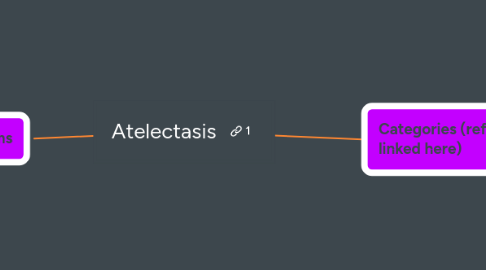
1. Mechanisms
1.1. Compressive
1.2. Resorptive (Absorption)
1.3. Adhesive
1.3.1. Impaired Surfactant Production
2. Categories (reference material is linked here)
2.1. Obstructive
2.1.1. a.k.a - Resorptive Atelectasis
2.1.1.1. Children at worst risk due to poorly developed collateral ventilation pathways
2.1.1.1.1. Intrathoracic tumors, mucous plugs, and foreign bodies in the airway
2.1.1.1.2. Absorptive atelectasis that happens during induction of, and intra-operative anesthesia
2.2. Non-obstructive
2.2.1. Compression
2.2.1.1. increased pressure exerted on the lung causing the alveoli to collapse
2.2.2. Adhesive
2.2.2.1. Result of a surfactant deficiency or dysfunction
2.2.2.1.1. ARDS
2.2.2.1.2. RDS in premature neonates
2.2.3. Cicatrization
2.2.3.1. Result of parenchymal scarring of the lung, leading to contraction of the lung
2.2.3.1.1. tuberculosis
2.2.3.1.2. fibrosis
2.2.3.1.3. Other chronic destructive lung processes
2.2.4. Relaxation
2.2.4.1. Involves the loss of contact between parietal and visceral tissue as seen in pneumothoraces and pleural effusions.
2.2.5. Replacement
2.2.5.1. One of the most severe forms and occurs when all of the alveoli in an entire lobe are replaced by tumor.
2.2.5.1.1. Bronchioalveolar carcinoma - results in complete lung collapse.
2.3. Post-operative
2.3.1. May be due to all of the above
2.3.2. Absorptive & Compression are most common mechanisms.
2.4. Rounded
2.4.1. less common and often seen in asbestosis
2.4.1.1. Pathophysiology - Folding of the atelectatic lung tissue to the pleura
